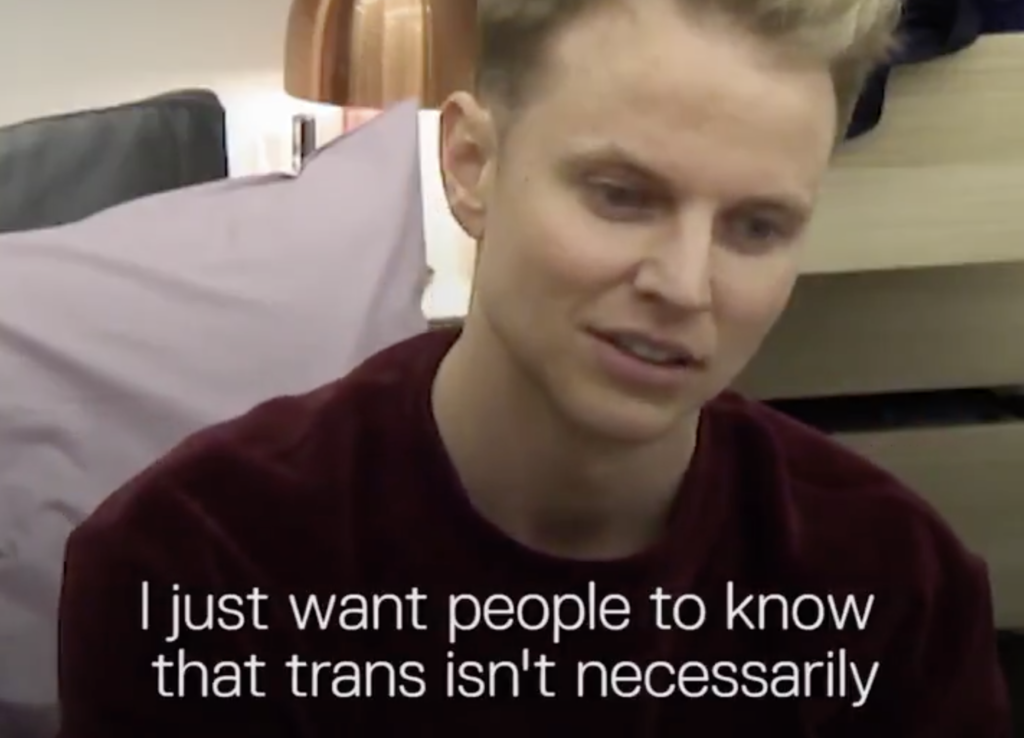
Whilst LGBT+ history month is a time to celebrate the progress of queer liberation, the rise of conservative regimes across the world has made it increasingly important to reflect on the harms still suffered by LGBT+ individuals during a time that was described by Advocate as “the deadliest year for trans Americans on record”.
This fact has not gone unnoticed by the media and Yas Necati reminds us of the following:
…to be LGBTQ+ is not just about who you’re attracted to or what gender you identify with, but also about whether you’ll make it through the next day, and how you’ll make it through that day. Particularly if you’re a person of colour. Particularly if you’re transgender.
– The Independent, 2018.
Whilst this quote refers to the violence that LGBTQ+ individuals still face on a daily basis, I believe it stands to reason that this contributes directly to the ‘minority stress’ which has been previously linked to mental illness in those affected (Barrett J, 2014; Heylens G et al., 2014). This is important to bear in mind when considering the article by Mueller and colleagues (2017) which examines risk factors for psychiatric comorbidity as well as commenting on evidence surrounding neurobiological aetiology.

“325 reported murders of trans and gender non-conforming people between October 2016 and September 2017” – Trans Murder Monitoring Project.
Methods
Beyond extrapolating from the title of the article (Transgender Research in the 21st Century: A Selective Critical Review From a Neurocognitive Perspective) the methodology employed by Mueller et al. in this review is unclear. Unfortunately, there is no comment on the search terms, databases or inclusion criteria for papers examined by the authors.
Results
- They report an increasing prevalence of trans individuals seeking gender services as well as noting a meta-analysis (Arcelus et al., 2015) of reported prevalence of transgender persons at 4.6 per 100,000, 6.8 for trans women and 2.6 for trans men. No comment is made about any non-binary groups
- They note the finding that affective disorders are the most common psychiatric comorbidity in those diagnosed with gender dysphoria, followed by anxiety disorders (Heylens et al., 2014)
- The authors comment that longitudinal studies have begun to show positive changes in mental health subsequent to a ‘successful transition’ and refer readers to a review by Dhejne et al. (2016)
- Pooled estimates of suicide attempts in trans persons range from 30-81% (Heylens et al., 2014; Clements-Nolle et al., 2006; Haas et al., 2014; Reisner et al., 2014)
- Referring to data found by Jones et al. (2012), they comment that currently available data suggests high rates of autistic traits in trans persons experiencing gender dysphoria
- The authors comment that the search for structural neurological correlates of transgenderism is still ongoing, however “promising MRI findings” in voice perception and olfaction have been published (Berglund et al., 2008; Burke et al., 2014).

Pooled estimates of suicide attempts in trans persons range from 30-81%.
Conclusions
The authors conclude that “available data suggest high rates of affective disorders that may decrease with treatment, although suicide risk remains a cause for concern” and recommend “larger-scaled collaborations for future validation and confirmation” of these findings.
Strengths and limitations
Any research that seeks to better understand and improve upon the experience of transgender individuals inherently has merit. Furthermore, this article draws attention to the sharp increase in those seeking to medically or surgically transition over the last 20 years as well as reiterating the high prevalence of affective disorders and suicidality within the transgender population. This will hopefully help to further sensitise clinicians to the needs of this small yet vulnerable group.
Fundamental to any discussion of transgender or gender-nonconforming populations is a robust understanding of the distinction between concepts and terms of gender, sex and sexuality and the harm incurred when these are conflated or used in a manner incongruous with what self-defining populations expect. As this was unfortunately the case in this article, I have included several aides memoire from the American Psychological Association (see below) and from Courtney Act (queer activist, drag queen and recent winner of Celebrity Big Brother).
A further limitation of the article was the failure to consider a wider range of non-binary identities and experiences that fall under the trans umbrella. This felt incongruous with the aim to provide a 21st Century perspective on transgender research.
The sections of the article which consider evidence for a neurobiological aetiology offer a back and forth between imaging evidence with little explanation of the findings that are presented in unnecessary verbiage. I believe it is also a fundamental flaw of this research to search for an ‘aetiology’. I feel this contributes to unnecessary pathologisation of trans existence and ignores the need to further understand the biopsychosocial underpinnings of mental illness in this group, so that adequate interventions can be developed.
Finally, I would like to reiterate the comments of Pitman and Rowe (2017) in an earlier Mental Elf blog which called for a “pause on conducting reviews and…–focus on primary research”. Such a shift is necessary if we seek to alter and not just comment on these estimates of suicidality and mental illness.

Courtney Act summarises gender fluidity on Celebrity Big Brother.
Implications for practice
I agree wholeheartedly with the authors’ comment that the prevalence of suicide attempts among transgender individuals is cause for concern. This staggering figure should act as yet another reminder that clinicians should discuss with their patients the idea of regular screening and risk assessment for mental illness, particularly suicidality and self-injurious behaviour.
Social prescribing may be of benefit to individuals who feel isolated or at risk from others. General practitioners and mental health professionals should have resources for peer-based community support for struggling trans people.

Social prescribing may be of benefit to individuals who feel isolated.
Conflicts of interest
The author has no conflicts of interest to declare.
Links
Primary paper
Müller S, De Cuypere G, T’Sjoen G. (2017) Transgender research in the 21st Century : a selective critical review from a neurocognitive perspective. American Journal of Psychiatry 2017; 174(12): 1155–62. DOI 10.1176/appi.ajp.2017.17060626
Other references
Heylens G, Elaut E, Kreukels BPC, et al: Psychiatric characteristics in transsexual individuals: multicentre study in four European countries. Br J Psychiatry 2014; 204:151–156 http://bjp.rcpsych.org/content/204/2/151
Barrett, J: Disorders of gender identity: what to do and who should do it?. Br J Psychiatry 2014; 204(2):96-97 http://bjp.rcpsych.org/content/204/2/96
Pitman A, Rowe S. Sexual orientation and suicidal behaviour: what are the specific risk factors for suicidality in young LGB people? The Mental Elf, 1 Aug 2017.
Arcelus J, Bouman WP, Van Den Noortgate W, et al: Systematic review and meta-analysis of prevalence studies in transsexualism. Eur Psychiatry 2015;30:807–815 https://www.sciencedirect.com/science/article/pii/S0924933815000917?via%3Dihub
Dhejne C, Lichtenstein P, Boman M, et al: Long-term follow-up of transsexual persons undergoing sex reassignment surgery: cohort study in Sweden. PLoS One 2011; 6:e16885 http://journals.plos.org/plosone/article?id=10.1371/journal.pone.0016885
Clements-Nolle K, Marx R, Katz M: Attempted suicide among transgender persons: the influence of gender-based discrimination and victimization. J Homosex 2006; 51:53–69 https://www.ncbi.nlm.nih.gov/pubmed/17135115?dopt=Abstract
Haas AP, Rodgers P, Herman JL: Suicide attempts among transgender and gender non-conforming adults: findings of the National Transgender Discrimination Survey. Los Angeles, UCLA, Williams Institute, Jan 2014 https://williamsinstitute.law.ucla.edu/research/suicide-attempts-among-transgender-and-gender-non-conforming-adults/
Reisner SL, White JM, Bradford JB, et al: Transgender health disparities: comparing full cohort and nested matched-pair study designs in a community health center. LGBT Health 2014; 1:177–184 https://www.ncbi.nlm.nih.gov/pmc/articles/PMC4219512/
Jones RM, Wheelwright S, Farrell K, et al: Brief report: female-to-male transsexual people and autistic traits. J Autism Dev Disord 2012; 42:301–306 https://link.springer.com/article/10.1007%2Fs10803-011-1227-8
Berglund H, Lindström P, Dhejne-Helmy C, et al: Male-to-female transsexuals show sex-atypical hypothalamus activation when smelling odorous steroids. Cereb Cortex 2008; 18:1900–1908 https://academic.oup.com/cercor/article-lookup/doi/10.1093/cercor/bhm216
Burke SM, Cohen-Kettenis PT, Veltman DJ, et al: Hypothalamic response to the chemo-signal androstadienone in gender dysphoric children and adolescents. Front Endocrinol (Lausanne) 2014; 5:60 https://www.ncbi.nlm.nih.gov/pmc/articles/PMC4037295/
Aides memoire
- http://www.independent.co.uk/voices/lgbt-history-month-queer-transgender-violence-discrimination-a8189036.html
- American Psychological Association sexuality definitions (PDF)
- Trans Murder Monitoring Project – 2017 (PDF)
Transgender support services
- http://www.mermaidsuk.org.uk/ – Family and individual support for gender diverse and transgender children and young people.
- www.stonewall.org.uk – Information and support for the LGBTQ+ community and their allies.
If you are experiencing suicidal thoughts or feelings
If you are experiencing suicidal thoughts or feelings, support is available from the following organisations:
Samaritans offer a 24 hours a day, 7 days a week support service. Call them FREE within the UK or the Republic of Ireland on 116 123.
If you live outside the UK or the Republic of Ireland, we recommend finding a local Crisis Centre on the IASP website.
Photo credits
- lisamikulski CC BY 2.0
- Ted Eytan CC BY 2.0
- Photo by Joshua Sazon on Unsplash
- Photo by Monica Melton on Unsplash

[…] Mental illness and neurobiological correlates in the transgender population […]
[…] D. Mental illness and neurobiological correlates in the transgender population. The Mental Elf, 16 Feb […]